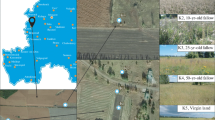Abstract
Features of the development of steppe chernozems were established based on the study of soils of different age groups at archaeological sites. Differences in the formation of phytomass and morphological maturity of the soil profile in the recovery of different age successions were shown. A regional model of the humus horizon steppe soil over time allowed us to estimate the time interval at which the processes of humus accumulation and morphological maturity of the soil profile are relatively at equilibrium, viz., 1700–1900 years.
Similar content being viewed by others
References
Dobrovol’skii, G.V. and Nikitin, E.D., Sokhranenie pochv kak nezmeninogo komponenta biosfery (Protection of Soils as an Important Component of Biosphere), Moscow: Nauka, 2000, 185 p.
Solovichenko, V.D., Lukin, S.V., Lisetskii, F.N., and Goleusov, P.V., Kranaya kniga pochv Belgorodskoi oblasti (Red Book of Soils of Belgorod Oblast’), Belgorod: BelGU, 2007, 139 p.
Lisetskii, F.N., Regional Red Book of Soils and Protection of Steppe Ecosystems, Stepnoi Byulleten’, 2007, no. 23–24, pp. 50–52.
Moysiyenko, I. and Sudnik-Wojcikowska B., The Flora of Kurgans in the Steppe Zone of Southern Ukraine — Phytogeographical and Ecological Aspects, Polish Botanical Studies, 2006, vol. 22, pp. 387–398.
Alexander, M., Management Planning for Nature Conservation: A Theoretical Basis and Practical Guide, Dordrecht: Springer, 2008, 425 p.
Dergacheva, M.I., Soil Ecology: Development of New Science of Biosphere Class, Sibirskii Ekologichekii Zhurnal, 2009, no. 2, pp. 143–150.
Nikonov, A.A., Pakhomov, M.M., Cherkinskii, A.E., and Chichagova, O.A., To Paleogeography of Kerch Peninsula in Holocene and Late Pleistocene, DAN, 1993, vol. 328, no. 2, pp. 221–225.
Marinich, A.M., Pashchenko, V.M., and Shishchenko, P.G., Priroda Ukrainskoi SSR. Landshafty i fizikogeograficheskoe raionirovanie (Nature of Ukrainian SSR. Landscapes and Physical-Geographical Zonning), Kiev: Naukova Dumka, 1985, 224 p.
Didukh, Ya.P. and Shelyag-Sosonko, Yu.R., Feather-Grass Steppe Chigini (Crimea), Ukrainskii Botanicheskii Zhurnal, 1980, vol. 37, no. 4, pp. 79–84.
Blazhnii, E.S., Pochvennyi ocherk Tamanskogo poluostrova (Soil Description of Tamansk Peninsula), Krasnodar, 1926, 31 p.
Mil’kov, F.N., Problem of Relicts in Physical Geography, Izv. Akad. Nauk, 1989, no. 6, pp. 5–15.
Bolgov, N.N., Bospor Kimmeriiskii (Bospor Kimmeriiskii), Belgorod: BelGU, 2003, 80 p.
Lisetskii, F.N., Goleusov, P.V., Chepelev, O.A., et al., Soil-chronological Database, no. 2010620434, Registered on August 16, 2010.
Lisetskii, F.N. and Ergina, E.I., Soil Development on the Crimean Peninsula in the Late Holocene, Pochvovedenie, 2010, no. 6, pp. 643–657.
Lisetskii, F.N., Periodization of Antropogenically Determined Evolution of Steppe Ecosystems, Ekologiya, 1992, no. 5, pp. 17–25.
Gromova, V.S., Degradation of Plant Wastes in Dry-Steppe Zone Affected by Different Factors, Extended Abstract of Cand. Sci. (Biol.) Dissertation, Moscow, 1978.
Veden’kov, E.P., Scientific Description of Protection Regime of Steppe Reserve “Askaniya-Nova”, in Problemy okhrany genofonda i upravleniya ekosistemami v zapovednikakh stepnoi i pustynnoi zon (Problems of Protection of Gene Pool and Management of Ecosystems in Reserves of Steppe and Desert Zones), Moscow, 1984, pp. 78–81.
Lisetskii, F.N., Autogenic Succession of Steppe Vegetation in Postantique Landscapes, Ekologiya, 1998, no. 4, pp. 252–255.
Jenny, H., The Soil Resource. Origin and Behavior, New York: Heidelberg, 1980, 377 p.
Rozhkov, V.A., Organizational Aspect of Soil Evolution, in Evolyutsiya pochvennogo pokrova. Istoriya idei i metody, golotsenovaya evolyutsiya, prognozy (Evolution of Soil. Development of Ideas and Methods, Holocene Evolution and Forecasts), Pushchino, 2009, pp. 37–39.
Lisetskii, F.N., A Model of Trend Component of Holocene Soil Formation, Reports of the Academy of Sciences of Ukraine. Mathematics, natural science, technical science, Doklady Akad. Nauk Ukrainy, 1994, no. 11, pp. 149–152.
Shmidt, V.M., Matematicheskie metody v botanike (Mathematical Methods in Botany), Leningrad: Leningr. Univ., 1984, 288 p.
Zhirmunskii, A.V. and Kuz’min, V.I., Kriticheskie urovni v razvitii prirodnykh system (Extreme Levels of Development of Natural Systems), Leningrad: Nauka, 1990, 223 p.
Gennadiev, A.N., Pochvy i vremya: modeli razvitiya (Soils and Time: Models of Development), Moscow: MGU, 1990, 232 p.
Goleusov, P.V. and Lisetskii, F.N., Soil Development in Anthropogenically Disturbed Forest-Steppe Landscapes, Eurasian Soil Science, 2008, vol. 41, no. 13, pp. 1480–1486.
Goleusov, P.V. and Lisetskii, F.N., Soil Development in Anthropogenically Disturbed Forest-Steppe Landscapes, Moscow: GEOS, 2009, 210 p.
Author information
Authors and Affiliations
Corresponding author
Additional information
Original Russian Text © F.N. Lisetskii, 2012, published in Sibirskii Ekologicheskii Zhurnal, 2012, No. 6, pp. 819–829.
Rights and permissions
About this article
Cite this article
Lisetskii, F.N. Soil reproduction in steppe ecosystems of different ages. Contemp. Probl. Ecol. 5, 580–588 (2012). https://doi.org/10.1134/S1995425512060108
Published:
Issue Date:
DOI: https://doi.org/10.1134/S1995425512060108



